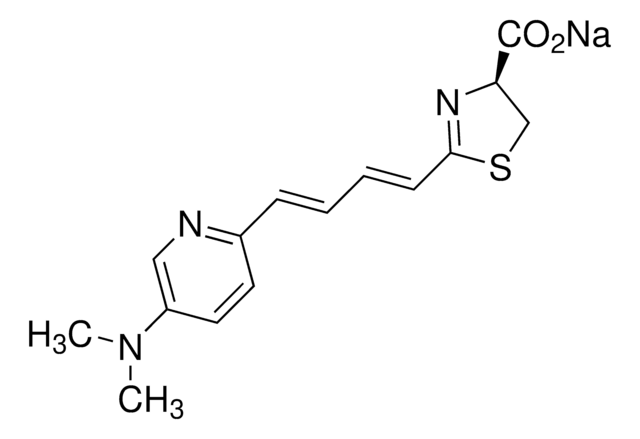808350
TokeOni
Synonym(s):
2-[(1E,3E)-4-[4-(Dimethylamino)phenyl]-1,3-butadien-1-yl]-4,5-dihydro-(4S)-4-thiazolecarboxylic acid hydrochloride salt, AkaLumine-HCl, Soluble NIR emission luciferin
About This Item
Recommended Products
form
powder
Quality Level
storage temp.
−20°C
SMILES string
CN(C)C1=CC=C(/C=C/C=C/C2=N[C@@H](C(O)=O)CS2)C=C1.[H]Cl
InChI
1S/C16H18N2O2S.ClH/c1-18(2)13-9-7-12(8-10-13)5-3-4-6-15-17-14(11-21-15)16(19)20;/h3-10,14H,11H2,1-2H3,(H,19,20);1H/b5-3+,6-4+;/t14-;/m1./s1
InChI key
PZCNKVAGZCXXHX-SSRSOBHISA-N
General description
- Luciferin is a generic term for the light-emitting compound found in organisms that generate bioluminescence.
- TokeOni is a new NIR emission luciferin analogue having luminescence peak at 670 ~ 680 nm with a peak range in the near-infrared (NIR) region.
- TokeOni has the enhanced solubility of >10 mg/mL compared to HCl free (0.2 mg/mL).
Application
- Bioimaging.
- in vivo imaging.
Storage Class Code
11 - Combustible Solids
WGK
WGK 3
Flash Point(F)
Not applicable
Flash Point(C)
Not applicable
Certificates of Analysis (COA)
Search for Certificates of Analysis (COA) by entering the products Lot/Batch Number. Lot and Batch Numbers can be found on a product’s label following the words ‘Lot’ or ‘Batch’.
Already Own This Product?
Find documentation for the products that you have recently purchased in the Document Library.
Customers Also Viewed
Articles
Bioluminescence imaging (BLI) systems allows for high-sensitive and noninvasive monitoring of cell proliferation, activity of signaling pathways and protein-protein interactions in living tissues.
seMpai substrate is suitable for near-infrared BLI in biological experiments, offering high solubility for extended bioluminescent applications.
seMpai substrate is suitable for near-infrared BLI in biological experiments, offering high solubility for extended bioluminescent applications.
seMpai substrate is suitable for near-infrared BLI in biological experiments, offering high solubility for extended bioluminescent applications.
Related Content
Organic electronics utilizes organic conductors and semiconductors for applications in organic photovoltaics, organic light-emitting diodes, and organic field-effect transistors.
Organic electronics utilizes organic conductors and semiconductors for applications in organic photovoltaics, organic light-emitting diodes, and organic field-effect transistors.
Our team of scientists has experience in all areas of research including Life Science, Material Science, Chemical Synthesis, Chromatography, Analytical and many others.
Contact Technical Service









